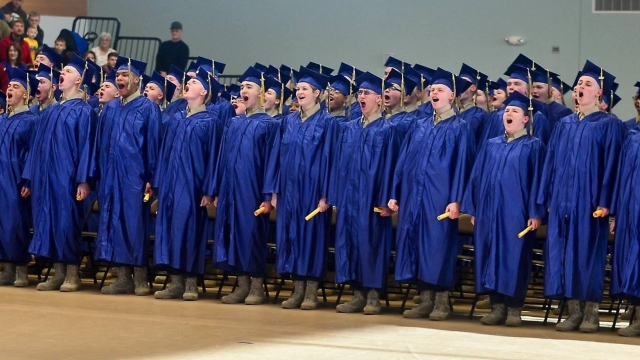
Preschool milestones are a time of celebration and pride for both children and their families. From learning to count to recognizing letters of the alphabet, these achievements deserve recognition. And what better way to honor these accomplishments than with the iconic symbol of academic achievement – the cap and gown.
While typically associated with high school and college graduation ceremonies, the tradition of wearing a cap and gown has made its way to the preschool level, creating a memorable experience for these young learners. Donning miniature versions of the regal attire, preschoolers are transformed into pint-sized graduates, radiating confidence and excitement as they take part in their own special ceremony.
Beyond the adorable factor, the preschool cap and gown ceremony holds deeper significance. It serves as a symbolic stepping stone, marking the transition from preschool to kindergarten and the next chapter of a child’s educational journey. It gives these young learners a taste of the importance of setting goals, working hard, and achieving success, instilling in them a sense of determination and drive from a tender age.
But why stop at preschool? Cap and gown ceremonies are now becoming popular for other academic milestones. From Kindergarten graduations to the completion of master’s degrees, students of all ages are embracing the tradition, donning their caps and gowns with pride as they commemorate their achievements. This timeless tradition symbolizes the years of hard work, dedication, and personal growth that culminate in a moment of triumph.
Whether it be the preschooler taking their first step towards education or the master’s degree graduate reaching the pinnacle of their academic pursuit, the cap and gown serves as a tangible reminder of their accomplishments and the limitless possibilities that lie ahead. So, let us celebrate these milestones, big and small, with the honor and respect they deserve – and what better way than with the timeless tradition of the preschool cap and gown?
The Importance of Recognizing Preschool Milestones
Recognizing preschool milestones holds immense significance in a child’s life. It serves as a stepping stone in their educational journey and lays the foundation for future achievements. Whether it’s their first day of school or their last, each milestone deserves to be celebrated and cherished. One way we can honor these early accomplishments is through the timeless tradition of preschool cap and gown attire.
The preschool years are a critical time in a child’s development. They learn essential social and cognitive skills that provide a strong base for their academic future. By recognizing and celebrating these milestones, we show children that their efforts and achievements are valued, building their self-confidence and motivation.
The symbolic act of donning a cap and gown for preschool ceremonies holds deep meaning. It represents the child’s transition from one phase of education to another, highlighting their growth and progress. Seeing themselves dressed in these special outfits not only makes them feel proud but also reinforces the significance of their achievements within their own minds.
In addition to recognizing preschool milestones, cap and gown ceremonies also foster a sense of community. Parents, family members, and teachers come together to show their support and encouragement for these young learners. This collective celebration creates a positive atmosphere that motivates children to continue striving for success.
By embracing the tradition of preschool cap and gown attire, we acknowledge and honor the significant milestones achieved by our little ones. We instill in them a sense of accomplishment and provide the encouragement they need to tackle future educational challenges. Let us celebrate these early achievements and pave the way for a bright educational future for our preschoolers.
The Symbolism of the Preschool Cap and Gown
The preschool cap and gown holds a powerful symbolism, marking a significant milestone in a child’s educational journey. It represents the culmination of early years filled with growth, learning, and play. As children don their miniature graduation attire, they are reminded of their achievement and the exciting possibilities that lie ahead.
Wearing a cap and gown at such a young age may seem unconventional, but it serves as an important symbol of preparation for future success. Just as college and university graduates wear caps and gowns to signify their academic accomplishments, preschoolers proudly wear these miniature versions, signifying their own readiness for the next stage of their educational journey.
The cap, often adorned with a tassel, represents the child’s individuality and unique talents. It symbolizes their ability to think critically and solve problems, even at such a tender age. The gown, flowing gracefully around their small frame, represents the knowledge and skills they have acquired during their preschool years, providing a sense of pride and accomplishment.
The preschool cap and gown also symbolize the support and encouragement received from teachers, parents, and caregivers. These garments represent the collective effort invested in a child’s early education, highlighting the importance of a nurturing and inspiring environment. By wearing the cap and gown, young graduates are reminded of the numerous individuals who have guided and shaped their learning experiences.
In conclusion, the preschool cap and gown hold a powerful symbolism, denoting the achievements, growth, and promise of our youngest learners. These tiny graduation garments represent the readiness for future success, individuality, acquired knowledge, and the support received throughout the preschool journey. As children proudly wear their cap and gown, they are celebrated for their accomplishments and inspired to continue their educational pursuits with enthusiasm and determination.
Exploring the Tradition of Master Degree Caps and Gowns
Traditions hold a special place in our lives, connecting us to our roots and marking significant milestones. The tradition of wearing caps and gowns during master degree ceremonies dates back many centuries, symbolizing the grandeur and achievement of this educational milestone. Just as preschool graduation ceremonies celebrate the accomplishments of young learners, master degree caps and gowns hold a distinguished significance for those who have dedicated years to higher education.
The cap, also known as the mortarboard, is a prominent feature of the master degree regalia. Its square shape with a tassel hanging from the top embodies a sense of scholarly attainment and expertise. The tassel itself holds its own meaning, often representing the academic field or area of specialization. With each graduate adorning their cap, the ceremony becomes a visual representation of the diverse range of knowledge and skills that have been achieved.
Kente Graduation Stoles
Alongside the cap, the gown serves as a symbol of honor and prestige. Historically, gowns were worn by scholars and clergy members as a mark of intellectual prowess. Today, they continue to signify the academic achievement and dedication of individuals who have attained a master’s degree. The gowns vary in style and color, often reflecting the university or academic institution from which the degree has been granted.
Seen as part of a long-standing tradition, the master degree cap and gown add a sense of formality and gravitas to graduation ceremonies. They serve as a visual representation of the hard work, dedication, and perseverance that each graduate has put into their academic journey. The cap and gown embody the pride and excitement felt by both graduates and their loved ones, making the ceremony a truly momentous occasion.
In conclusion, the tradition of wearing caps and gowns for master degree ceremonies is deeply rooted in history and holds immense meaning for graduates. The cap symbolizes scholarly achievement, while the gown signifies honor and prestige. By participating in this time-honored tradition, graduates not only celebrate their personal accomplishments but also join a long line of scholars who have come before them.



